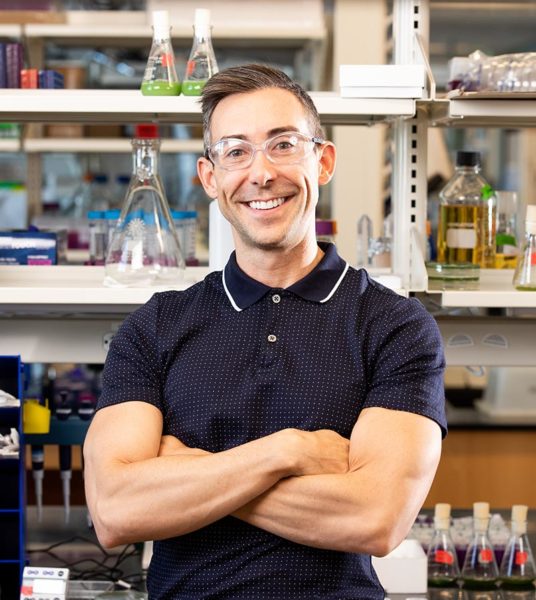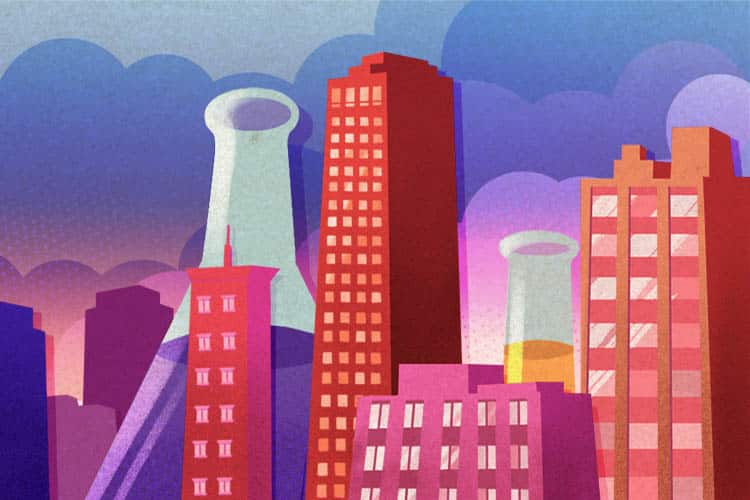Illustration by Megan Stump
A staple of American lore is the tale of the country lad who grows up, travels to the big city and outsmarts all the urban sophisticates with his ingenuity.
Professor Wil Srubar is a farm boy turned structural engineer who has a trick question for designers and builders of concrete structures: Do you think you know what’s living and what’s dead?
Your answer may be correct—for now. But Srubar and his team at the University of Colorado, Boulder, Living Materials Laboratory are on a mission to “blur the boundaries between what is living and non-living” in the realm of construction through biomaterials engineering.
What Srubar has in mind is integrating microorganisms within concrete so that it becomes self-healing. And while his work to date “stands on the shoulders of others” who have done preliminary experiments with this concept, Srubar’s team—which includes colleagues in biochemistry, microbiology, materials science and structural engineering—has brought the idea a step closer to reality.
What’s your building’s superpower?
“Our work was the first to take a new look at how microorganisms can participate in the growth of materials, in the manufacture of materials,” Srubar said. This biomaterials science research produced bacteria that, in the right environment, can remain alive, biologically active and able to help regenerate the bricks in which they’re living. “You could cut a brick in half, and two halves could grow into two full bricks.”

But that’s not the best part. What most excites Srubar is the potential for using this capacity as a technology platform that allows any biological response of an organism to become a property of a building material that contains that organism.
“Materials could sense and respond to harmful chemicals in the air,” Srubar said. “They could bio-luminesce under different types of light, revealing secret messages or self-heal in response to damage. The sky’s the limit with imagining the biological responsiveness of these materials, and that’s really where our work is heading.”
Getting the conditions right
To achieve that, Srubar and his team need to define the parameters of the environment required to manage controlled, systematic repair. The team has already determined that “you need precise triggers of temperature and humidity” to get biomaterials to regenerate. It is still experimenting with “micro fluidics” and what it will take to deliver the nutrients necessary to keep the biological system alive.
Given his background in structural engineering, Srubar is aware of structural and load-bearing applications—so while he has targets for the biomaterials’ mechanical properties, Srubar recognizes that they might be best suited to replacing “non-structural, lower-strength cementitious materials or even fillers or façade-type material.”
Once those questions are resolved, commercialization would present a new set of challenges, starting with the way the product is delivered to customers. Srubar envisions selling powder rather than bricks, so that customers would add water to the packaged dry culture (as they do now with Portland cement), perhaps in combination with fillers such as recycled glass, sawdust or even recycled cement.
‘Our work was the first to take a new look at how microorganisms can participate in the growth of materials, in the manufacture of materials … You could cut a brick in half, and two halves could grow into two full bricks.’
Will Srubar, Living Materials Laboratory, University of Colorado, Boulder
The aim is to add to rather than replace the tools architects, engineers and construction crews have at their disposal. “We didn’t want to change the way in which things are done too much,” Srubar said. “It does take a lot of time to turn the ship in an industry that is rooted in tradition.”
Instead, Srubar sees a future that offers “a little bit more flexibility on site with growing materials, especially in dense urban centers or in resource scarce environments.” The latter category could one day include the moon or other planets, where—with the aid of bacteria—local resources could be harvested to grow building biomaterials that it would not be feasible to ship from Earth.
Back to nature
In the end, Srubar hopes to spark an evolution not only in how construction materials are sourced, but also how human beings think about sourcing materials. That change could present itself in the form of bio-cement or photosynthetic organisms. It could mean simply making better use of natural fibers or even algae that could be “grown, encapsulated and transformed into high-performance building material,” Srubar said.
Srubar is also “trying to change the paradigm of the construction industry” and transforming it from a carbon emitter to a carbon sink. On that point, he cautions that the team has yet to release environmental impact data.
“However, what I can say is that we are using photosynthetic organisms—so cyanobacteria that utilize carbon dioxide, sunlight and water to grow,” Srubar said. “All of the biomass that’s produced during the growth phase is really sequestered carbon dioxide, which speaks to the carbon negativity of the material rather than having positive carbon emissions. The carbon footprint is exceptionally lower on a per-volume basis than Portland cement concrete. And we’re even getting some carbon storage from the biomass that is grown and encapsulated within the material.”











